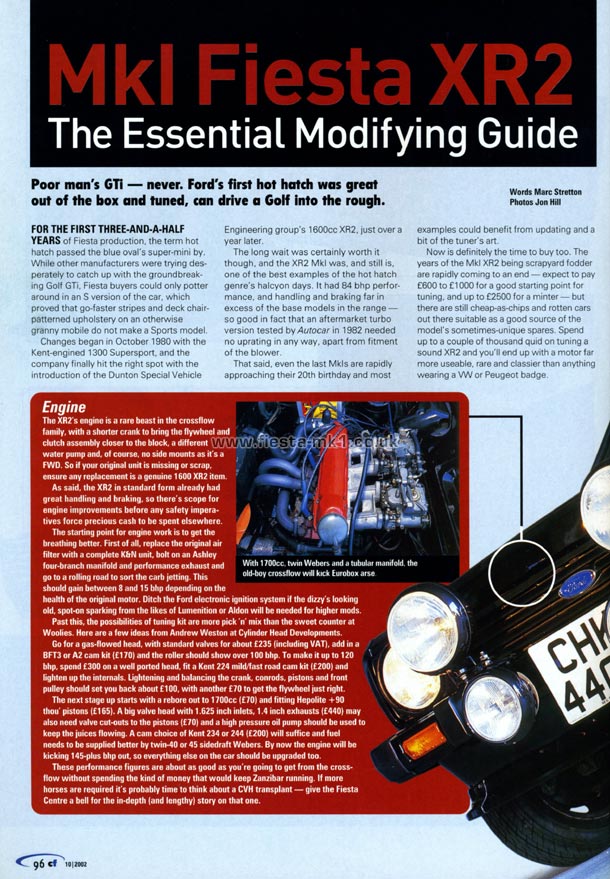Copy of Article Text Below
MK1 Fiesta XR2 - The Essential Modifying Guide - Poor man's GTi - never. Ford's first hot hatch was great out of the box and tuned, can drive a Golf into the rough.
Words Marc Stretton
Photos Jon Hill
For the first three-and-a-half years of Fiesta production, the term hot hatch passed the blue oval's super-mini by. While other manufacturers were trying desperately to catch up with the groundbreaking Golf GTi, Fiesta buyers could only potter around in an S version of the car, which proved that go-faster stripes and deck chair-patterned upholstery on an otherwise granny mobile do not make a Sports model. Changes began in October 1980 with the Kent-engined 1300 Supersport, and the company finally hit the right spot with the introduction of the Dunton Special Vehicle Engineering group's 1600ccXR2, just over a year later.
The long wait was certainly worth it though, and the XR2 Mk1 was, and still is, one of the best examples of the hot hatch genre's halcyon days. It had 84 bhp performance, and handling and braking far in excess of the base models in the range - so good in fact that an aftermarket turbo version tested by Autocar in 1982 needed no uprating in any way, apart from fitment of the blower.
That said, even the last Mk1s are rapidly approaching their 20th birthday and most examples could benefit from updating and a bit of the tuner's art.
Now is definitely the time to buy too. The years of the Mk1 XR2 being scrapyard fodder are rapidly coming to an end - expect to pay £600 to £1000 for a good starting point for tuning, and up to £2500 for a minter - but there are still cheap-as-chips and rotten cars out there suitable as a good source of the model's sometimes-unique spares. Spend up to a couple of thousand quid on tuning a sound XR2 and you'll end up with a motor far more useable, rare and classier than anything wearing a VW or Peugeot badge.
Engine
The XR2's engine is a rare beast in the crossflow family, with a shorter crank to bring the flywheel and clutch assembly closer to the block, a different water pump and, of course, no side mounts as it's a FWD. So if your original unit is missing or scrap, ensure any replacement is a genuine 1600 XR2 item.
As said, the XR2 in standard form already had great handling and braking, so there's scope for engine improvements before any safety imperatives force precious cash to be spent elsewhere.
The starting point for engine work is to get the breathing better. First of all, replace the original air filter with a complete K&N unit, bolt on an Ashley four-branch manifold and performance exhaust and go to a rolling road to sort the carb jetting. This should gain between 8 and 15 bhp depending on the health of the original motor. Ditch the Ford electronic ignition system if the dizzy s looking old, spot-on sparking from the likes of Lumenition or Aldon will be needed for higher mods.
Past this, the possibilities of tuning kit are more pick 'n' mix than the sweet counter at Woolies. Here are a few ideas from Andrew Weston at Cylinder Head Developments.
Go for a gas-flowed head, with standard valves for about £235 (including VAT), add in a BFT3 or A2 cam kit (£170) and the roller should show over 100 bhp. To make it up to 120 bhp, spend £300 on a well ported head, fit a Kent 224 mild/fast road cam kit (£200) and lighten up the internals. Lightening and balancing the crank, conrods, pistons and front pulley should set you back about £100, with another £70 to get the flywheel just right.
The next stage up starts with a rebore out to 1700cc (£70) and fitting Hepolite +90 thou' pistons (£165). A big valve head with 1.625 inch inlets, 1.4 inch exhausts (£440) may also need valve cut-outs to the pistons (£70) and a high pressure oil pump should be used to keep the juices flowing. A cam choice of Kent 234 or 244 (£200) will suffice and fuel needs to be supplied better by twin-40 or 45 sidedraft Webers. By now the engine will be kicking 145-plus bhp out, so everything else on the car should be upgraded too.
These performance figures are about as good as you're going to get from the cross-flow without spending the kind of money that would keep Zanzibar running. If more horses are required it's probably time to think about a CVH transplant - give the Fiesta Centre a bell for the in-depth (and lengthy) story on that one.
Captions -
Middle - With 1700cc, twin Webers and a tubular manifold, the old-boy crossflow will kick Eurobox arse
|






